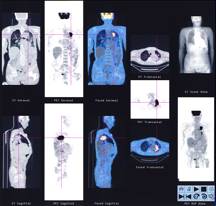What Happens Before, During and After Treatment
Once the diagnosis has been made, you will probably talk with your primary care physician along with several cancer specialists, such as a surgeon, a medical oncologist and a radiation oncologist, to discuss your treatment choices. These specialists will work together to help recommend the best treatment for you.
In some cases, your cancer will need to be treated by using more than one type of treatment. For example, if you have breast cancer, you might have surgery to remove the tumor (by a surgeon), then have radiation therapy to destroy any remaining cancer cells in or near your breast (by a radiation oncologist). You also might receive chemotherapy (by a medical oncologist) to destroy cancer cells that have traveled to other parts of the body.
Before Treatment
Consultation with a Radiation Oncologist
 If you are considering radiation therapy, you must first meet with a radiation oncologist to see if radiation therapy is right for you. During your first visit, your doctor will evaluate your need for radiation therapy and its likely results. This includes reviewing your current medical problems, past medical history, past surgical history, family history, medications, allergies and lifestyle. The doctor will also perform a physical exam to assess the extent of your disease and judge your general physical condition.
If you are considering radiation therapy, you must first meet with a radiation oncologist to see if radiation therapy is right for you. During your first visit, your doctor will evaluate your need for radiation therapy and its likely results. This includes reviewing your current medical problems, past medical history, past surgical history, family history, medications, allergies and lifestyle. The doctor will also perform a physical exam to assess the extent of your disease and judge your general physical condition.
After reviewing your medical tests, including CT scans, MRI scans and PET scans, and completing a thorough examination, your radiation oncologist will discuss with you the potential benefits and risks of radiation therapy and answer your questions.
Simulation and Treatment Planning
To be most effective, radiation therapy must be aimed precisely at the same target or targets each and every time treatment is given. The process of measuring your body and marking your skin to help your team direct the beams of radiation safely and exactly to their intended locations is called simulation.
 |
During simulation, your radiation oncologist and radiation therapist place you on the simulation machine ( specialized dedicated CT scanner) in the exact position you will be in during the actual treatment. Your radiation therapist, under your doctor’s supervision, then marks the area to be treated directly on your skin or on immobilization devices. Immobilization devices are molds, casts, headrests or other devices that help you remain in the same position during the entire treatment. The radiation therapist marks your skin and/or the immobilization devices either with a bright, temporary paint or a set of small, permanent tattoos. |
Treatment Planning

Once you have finished with the simulation, your radiation oncologist and other members of the treatment team review the information they obtained during simulation along with your previous medical tests to develop a treatment plan. Sophisticated treatment-planning computer software is used to help design the best possible treatment plan. After reviewing all of this information, your doctor will write a prescription that outlines exactly how much radiation you will receive and to what parts of your body.
During Treatment
Weekly Status Checks
During radiation therapy, your radiation oncologist and nurse will see you regularly to follow your progress, evaluate whether you are having any side effects, recommend treatments for those side effects (such as medication) and address any concerns you may have. As treatment progresses, your doctor may make changes in the schedule or treatment plan depending on your response or reaction to the therapy.
Your radiation therapy team may gather on a regular basis with other healthcare professionals to review your case to ensure your treatment is proceeding as planned. During these sessions, all the members of the team discuss your progress as well as any concerns.
If you are treated with external beam radiation -- during your course of treatment, correct positions of the treatment beams will be regularly verified with images made using the treatment beam itself. These images (called port films, beam films or portal verification) represent an important quality assurance check, but do not evaluate the tumor itself.
After Treatment
Follow-Up
 After treatment is completed, follow-up appointments will be scheduled so that your radiation oncologist can make sure your recovery is proceeding normally and can continue to monitor your health status. Your radiation oncologist may also order additional diagnostic tests. Reports on your treatment may also be sent to the other doctors helping treat your cancer.
After treatment is completed, follow-up appointments will be scheduled so that your radiation oncologist can make sure your recovery is proceeding normally and can continue to monitor your health status. Your radiation oncologist may also order additional diagnostic tests. Reports on your treatment may also be sent to the other doctors helping treat your cancer.
As time goes by, the number of times you need to visit your radiat
ion oncologist will decrease. However, you should know that your radiation oncology team will always be available should you need to speak to someone about your treatment

